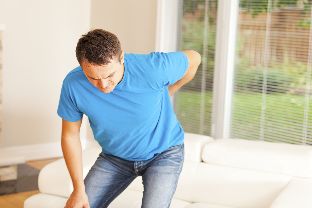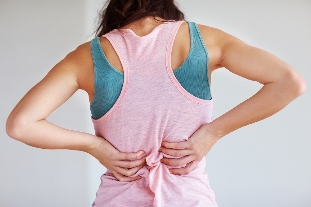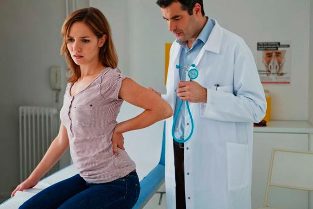Back pain - a frequent symptom. Most people, at least once in life were with him. This is one of the most common causes of visits to the doctor, and the omission of work.

Key words: back pain, pain in the back, the spine
Back pain can occur at any age, but is most common between 35 and 55 years. The pain in the spine is related to the fact of how our bones, muscles, intervertebral discs m? s, the ligaments, tendons and nerves.
The pain in the spine can be caused by problems with the vertebrae, discs between them, the ligaments around the spine and discs, spinal cord and nerves, muscles of the back, the internal organs of the abdomen and pelvis in the areas. Also cause pain in the upper back may be the disease of the aorta, a tumor in the chest and inflammation of the spine.
Risk factors
The presence of risk factors increases the likelihood of development of one state or another. For example, obesity significantly raises the risk of developing type ii diabetes.
The following factors are associated with an increase in the risk of occurrence of pain in the back:
- office work;
- the work, combined with the constant stress;
- pregnancy: pregnant women often suffer from pain in the spine;
- the sedentary lifestyle;
- age;
- depression;
- obesity/overweight;
- smoking;
- heavy exercise;
- heavy-duty work.

The signs and symptoms of pain in the back
The symptom is what the patient feels, then, as a sign that you may notice the doctor. For example, pain is a symptom, while a rash is a symptom of.
The main symptom of pain in the spine is pain in any part of the back. Sometimes the pain extends to the buttocks and legs or in the shoulder and the hand.
You should immediately contact your doctor if the pain in the spine accompanied to any of the following signs:
- the weight loss;
- high temperature (fever);
- the back pain is not easy, after a trip;
- irradiation of pain in the leg;
- the pain down below the knee;
- the presence of the fresh injury of the spine;
- incontinence of urine (even a small portion);
- difficulty urinating - urine passes with ease;
- fecal incontinence is the loss of control over the process of defecation;
- sensation of numbness in the genital area;
- sensation of numbness in the area of the anus;
- numbness in the buttocks.
Contact with the advice of a health professional if you belong to one of these groups:
- persons under 22 years of age or over 55 years of age.
- patients who took steroids for several months.
- patients with cancer;
- patients who have had cancer;
- patients with low immunity.
Causes of back pain
Man, the spinal column is a complex structure, formed by the muscles, ligaments, tendons, disks and bones. Intervertebral discs m? s are located between each pair of vertebrae and function as shock absorbers of friction. The problem with any of these components can cause pain in the spine. In some cases, the cause of the pain cannot be established.

Traction
The common causes of pain in the spinal column are:
- laying of the muscles;
- stretched ligaments;
- the climb heavy objects in a bad posture;
- the climb is too heavy of an object;
- the result of the acute, and of a clumsy movement;
- the spasm of the muscles.
The structural problems of
These structural problems, can cause pain in the spine:
- the protrusion of the intervertebral disc. The rupture of the outer sheath of the unit leads to the vbuhanie its internal contents to the outside. This can lead to jammed nerves and, as a result, the pain;
- the hernia of intervertebral disc - bulging internal the contents of a disk of large size;
- sciatica - sharp, stabbing pain that radiates into the buttock and the back in the area of the feet caused by protrusion or herniation of intervertebral disc, compressing the nerve;
- arthritis - patients with osteoarthritis often have problems with the joints of the hip, lumbar spine, knees and hands. In some cases, it can result in stenosis of the spinal canal, as well as the space around the spinal cord is narrowed;
- abnormal curvature of the spine - if the spine is bent in an unusual way, the patient will be more prone to suffer from pain in the spine. An example of abnormal flexing is scoliosis, where the spine bends towards;
- osteoporosis of the bones, including the vertebrae, become brittle and porous, which causes an increase of its fragility.
Below are some of the other causes of pain in the spinal column:
- the syndrome of the tail - a ponytail is a bunch of nerve roots, which are branches of the spinal cord. People with the syndrome of the tail of a horse feel a dull pain in the lumbar region of the spine and the buttocks. There may also be loss of sensation of the buttocks, the genitals, and in the hip. Sometimes, people with the syndrome of the tail of a horse suffering from incontinence of urine and/or feces;
- cancer of the spine - a tumor located in the spine, can compress the nerve, leading to pain;
- infection of the spine - if the patient is observed a high body temperature, as well as a painful hot area on the back, then you can talk about the infection of the spinal column;
- other of the infection - pelvic inflammatory disease in women, as well as infections of the bladder and of the kidneys may also be the cause of back pain;
- sleep disorders - people with sleep disorders often experience pain in the spine in relation to the total population;
- herpes zoster is an infection that can affect your nerves;
- good mattress - if the mattress does not support certain parts of the body and is not provided to uniform the position of the back, there is the risk of developing pain in the spine.
Also the cause of pain in the spinal column can be defined as movement or the position of the body, such as the length of the ride, the cough, etc

What to do when it hurts the back
If you experience pain in the spine for several days, the following tips will help you reduce the pain and discomfort and speed up recovery:
- stay active to the extent possible;
- if necessary, use OTC analgesics;
- use hot or cold compresses and. Evil and a hot-water bottle, and a package of frozen food.
Despite the fact that it is difficult to remain optimistic when you are suffering from pain, try not to be discouraged. This will speed up the healing process.
Continuous pain in the spine, which does not happen in the period of six weeks, you should consult a doctor. The doctor will be the history of the disease, will review and, if necessary, be sent for additional studies. The doctor may prescribe x-rays when you suspect that there is a problem with the skeletal system or osteoarthrosis, ct (computerized tomography) or mri (magnetic resonance imaging) if it is suspected of an intervertebral hernia or any other problem related to the soft tissues, or nerves. In this situation, the magnetic resonance imaging is the best option. Also the doctor may advise to do some lab tests, or to measure the electrical activity of the nerves (emg).
After the diagnosis of a doctor prescribes the treatment. For the majority of cases, it is enough with conservative treatment, which may include:
- special exercises;
- reflexology;
- apply traction to the spinal column;
- the massage.
In severe cases, it can be raised the question about the realization of the operation. The surgeon Will help you choose the appropriate method, and can also advise on the possible complications. Some time after the operation is recommended to complete the preventative treatment of the spine. Remember that the operation on the spine are quite dangerous, as well as the screen size of beach is located close to the nerves.







































